Did you know that the smallest member of the lute family is known as the mandolin? The mandolin is a plucked string instrument with a neck and round back enclosing a hollow cavity, usually with a sound hole or opening in the body. Related to the guitar, there are many different styles of mandolins, but they are usually plucked with fingers, or after the invention of steel strings, plucked with a quill or plectrum.
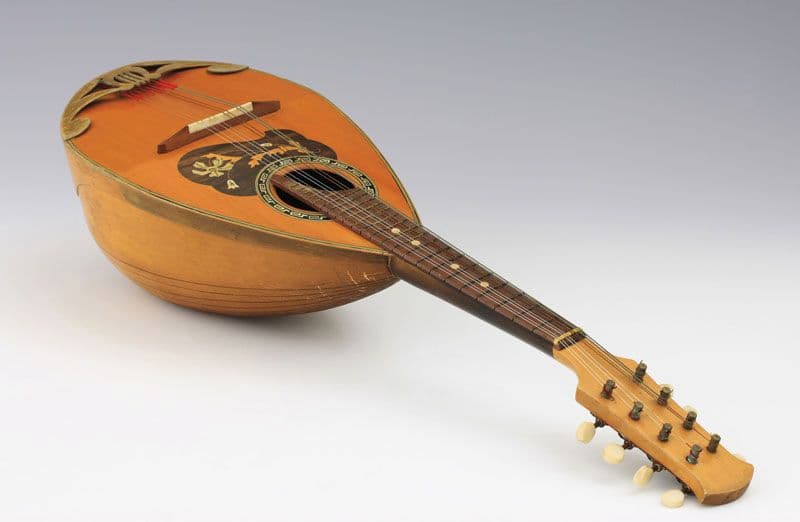
Mandolin
In the early eighteenth century, the mandolin was popular in Southern Italy, especially in Naples. The instrument was consistently used for informal music making, and important changes allowed the instrument to enter the world of art music. It was previously tuned in fourths and thirds, but in the second half of the 18th century the tuning in fifths, as with the violin, was adapted.
The mandolin became immediately popular in the field of dance and chamber music. In addition, the mandolin was used as an obbligato instrument in operas and oratorios, and increasingly as a solo instrument. We find solo sonatas and a rich selection of trios and quartets with one of two mandolini and varying combinations of string instruments. And it was only a matter of time before the mandolin started to play a leading role on the concerto stage. Once I started digging around, I found a surprising number of mandolin concertos. In this blog, I have compiled the 10 most exciting Mandolin Concertos.
Antonio Vivaldi
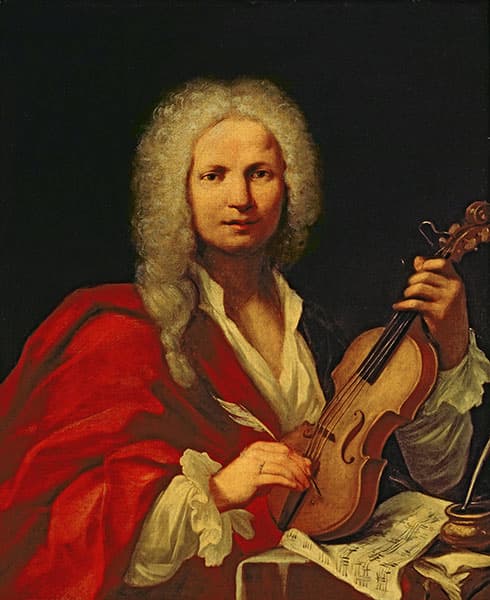
Portrait of Antonio Vivaldi
Antonio Vivaldi (1678-1741) composed close to 500 concertos, mostly for the violin or string ensembles. His most famous and popular concertos are undoubtedly The Four Seasons. Vivaldi wrote concertos for other instruments as well, and the Mandolin Concerto in C Major dates from 1725, the same year as the Four Seasons.
In all, Vivaldi composed three concertos for the mandolin probably intended for performance at the Ospedale della Pietà. It is possible that he specifically wrote the works for Anna Maria, one of the most talented orphan students at the orphanage. She was a violinist of exceptional talent but was also highly proficient in her performances on the mandolin.
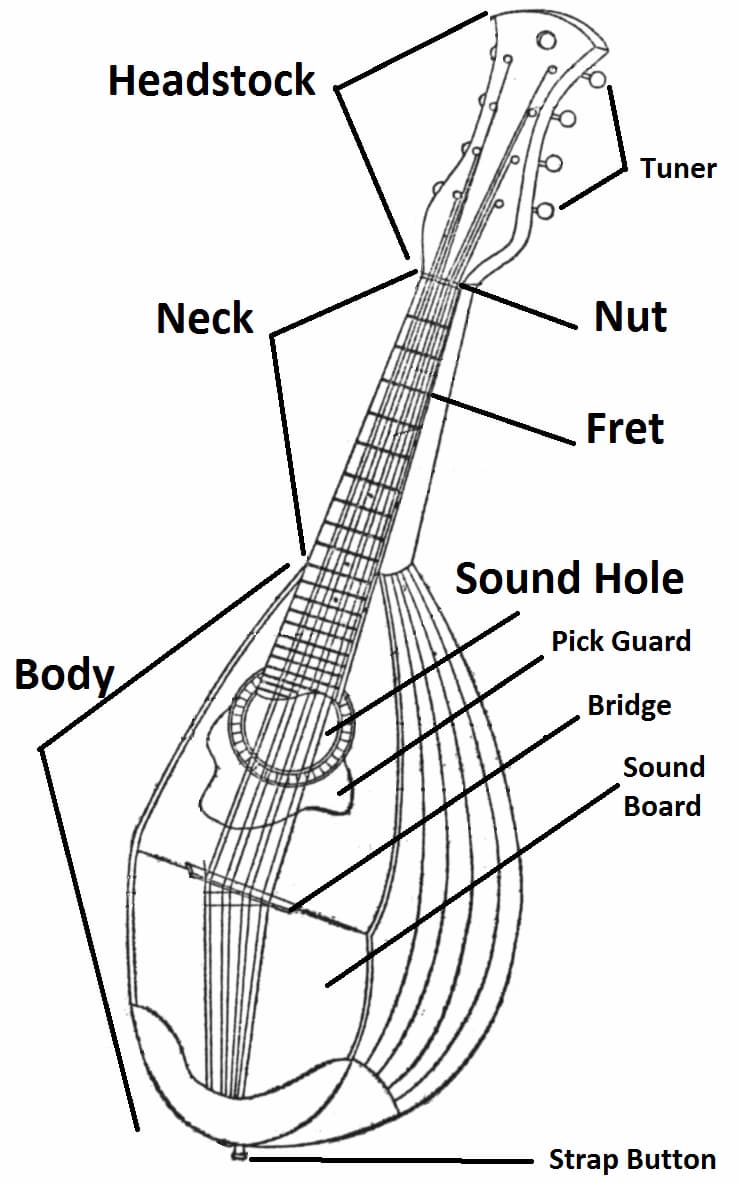
Parts of the mandolin
The Mandolin Concerto in C Major became a central work in the mandolin repertoire because it features “fully developed solo writing for the instrument and subtle orchestral balance.” Vivaldi paid special attention to the delicate balance between the mandolin and the orchestra. In fact, he even wrote in the score that the entire orchestra must adapt to the soloist’s delicate sonority and heavenly timbre. The slow movement is entirely based on the arpeggios and tremolo repertoire typical of mandolin technique, while the framing outer movements allow the thin voice of the mandolin to “emerge with clarity without having to relinquish any virtuosic brilliance.”
Antonio Vivaldi: Mandolin Concerto in C Major
Giovanni Paisiello
Giovanni Paisiello
Giovanni Paisiello (1740-1816) was the most popular opera composer of the late 1700s, and his operatic style greatly influenced Mozart and Rossini. Scholars are not sure why or indeed if, Paisiello tried his hands at a mandolin concerto. However, the National Library in Paris holds a manuscript written by a professional copyist entitled “Concerto a Mandolino solo con Violini e Basso.”
The Italian mandolin player Giuseppe Annedda attached the name Paisiello to the manuscript in the 1970s. Paisiello cannot be ruled out as the composer, but his name certainly adds more to the acceptance and appeal of the work than does the name “Anonymous.” The composer of the work, regardless, crafted a wonderful and exciting example of mandolin music.
Lighthearted, playful, and elegant, short playful motives give the work a bright and cheerful sound. According to experts, the key of E-flat Major is unusual for mandolin compositions, but it provides a smooth and flexible timbre for the solo instrument. In addition, the solo part clearly demonstrates a profound knowledge of the technical possibilities of the mandolin. The delightful suggestion of melancholy just beneath the surface provides beautiful evidence of the instrument’s popularity.
Giovanni Paisiello: Mandolin Concerto in E-flat Major (Anna Torge, mandolin; Kölner Akademie; Michael Alexander Willens, cond.)
Francesco Lecce
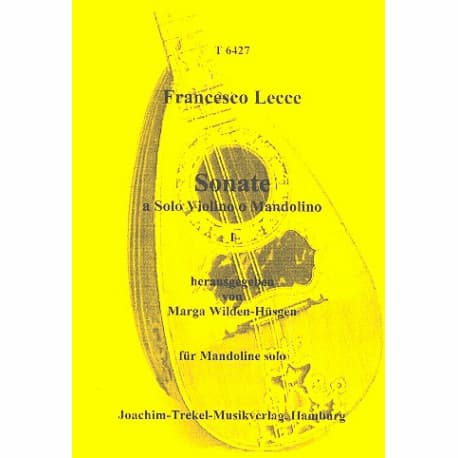
Francesco Lecce’s Sonata for violin or mandolin
Almost nothing is known of Francesco Lecce (fl. 1750-1806), except for the fact that he was musically active in Naples. His name appears among the violinists employed at the Musical Chapel of the Treasury of San Gennaro between around 1750 and 1799 and we still find him as a member of the Royal Chapel in Naples in 1806. He composed a set of sonatas and concerto for mandolin, which seems to have much in common with the formal and stylistic features of Paisiello.
Scored in the customary three movements, the work opens with an elegant and refined Allegro. The expressive Largo features a central episode in the home key that is framed by two sections in the minor mode, creating a delightful contrast that unfolds in well-shaped phrases. The concluding Allegro-Balleto pays homage to the virtuoso aspects of the soloist as the music alternates really fast and exciting flurries.
Francesco Lecce: Mandolin Concerto in G Major (Raffaele La Ragione, mandolin; Il Pomo d’Oro; Francesco Corti, cond.)
Raffaele Calace
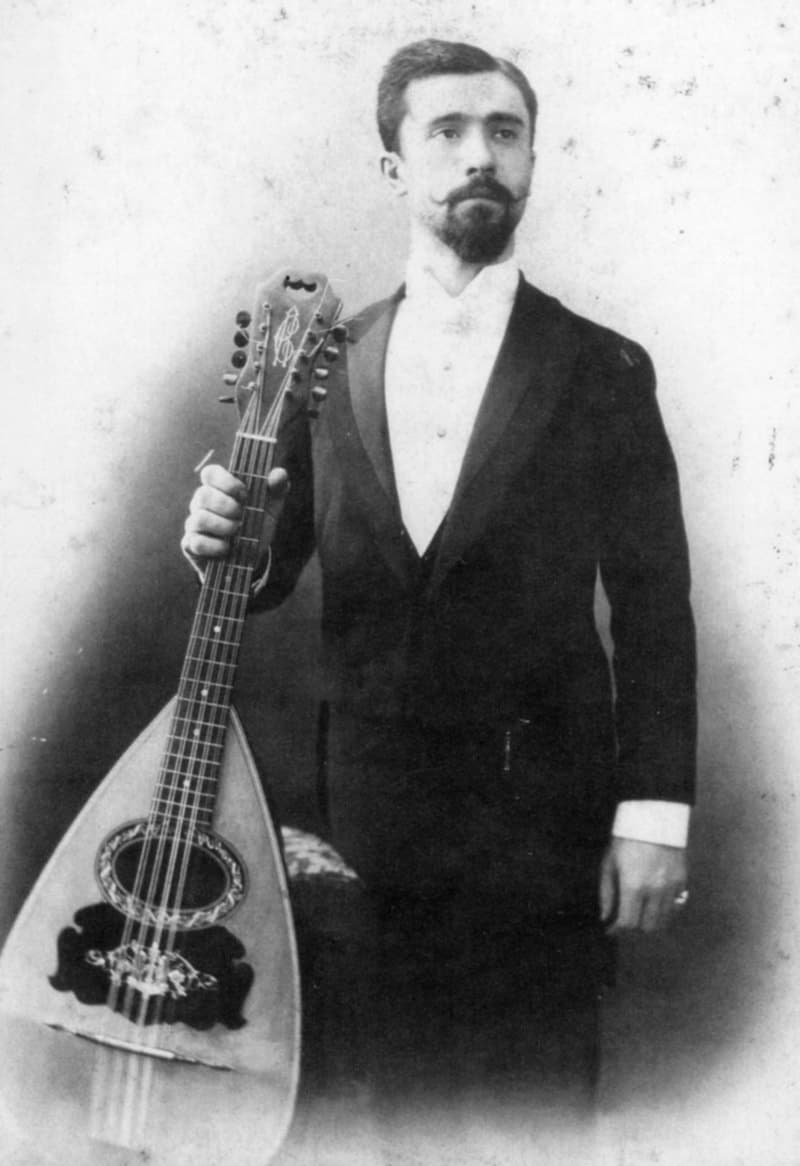
Raffaele Calace
Raffaele Calace (1862-1934) was born in Naples, the son of a successful instrument maker producing violins and mandolins. He was encouraged early on to take over the family business, and he also became a highly skilled mandolin virtuoso and composer. According to scholars, “he took mandolin techniques to new levels and was greatly admired for his expressive and beautiful playing.” He traveled the world and famously played for the Japanese emperor in 1924/5.
As a trained mandolin maker, Calace pushed the construction of the instrument to its limits. He increased the range of the instrument by extending the fingerboard over the sound hole. As a player, he made full use of this extended range as well as “developing and perfecting techniques that gave the mandolin more dimensions and allowed for huge ranges in dynamic and tonal contrasts.” In addition, he wrote almost 200 compositions for the mandolin, including concert works for mandolin solo and compositions for mandolin and other instruments.
The Mandolin Concerto No. 1 was originally written for mandolin and piano, and the composer probably never intended to have it orchestrated. By calling it a “Concerto,” Calace draws attention to the three-movement division of a substantial concert work rather than the traditional format of soloist and orchestra. As you can hear, the piano writing is far more than a simple accompaniment, as both instruments perform in equal parts and constantly interact with each other.
Raffaele Calace: Mandolin Concerto No. 1, Op. 113 (Alison Stephens, mandolin; Steven Devine, piano)
Johann Nepomuk Hummel
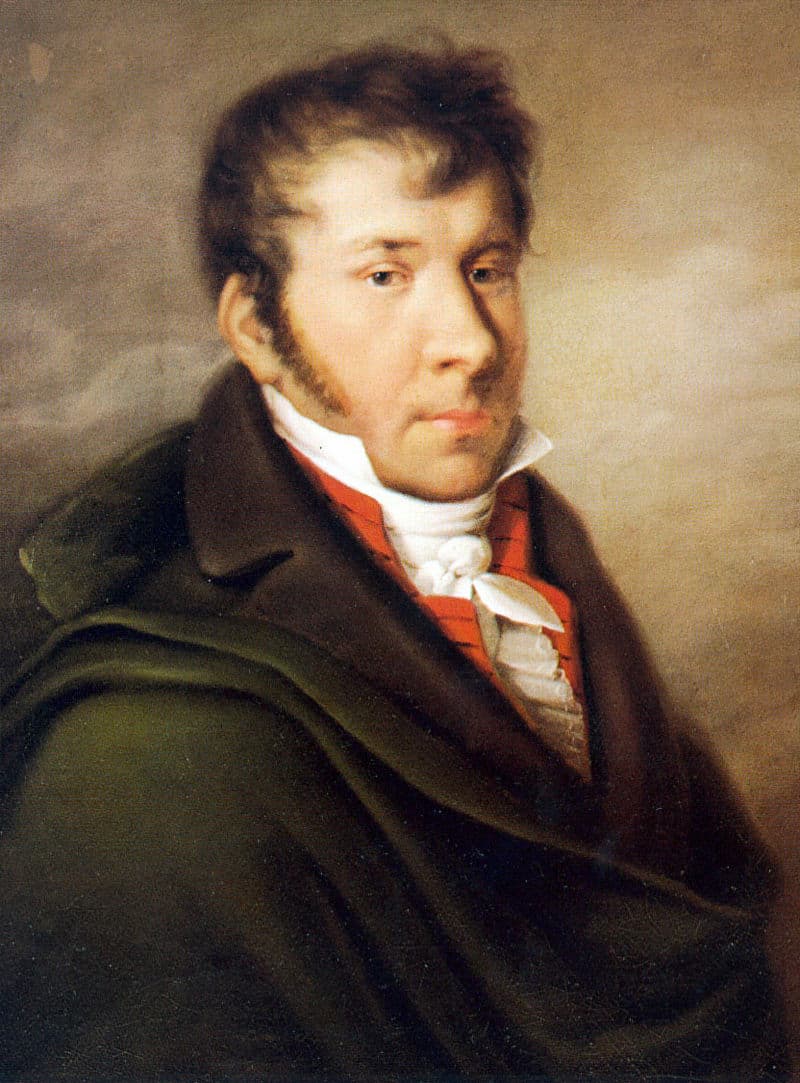
Johann Nepomuk Hummel, 1814
The name Johann Nepomuk Hummel (1778-1837) is generally not associated with the mandolin. Rather, we know him as a child prodigy and virtuoso pianist who received instruction from Wolfgang Amadeus Mozart. However, during his time in Vienna, he became acquainted with Bartolomeo Bortolazzi, a noted mandolin and guitar virtuoso who also authored the first theoretical book on the mandolin in German. As such Bortolazzi was responsible for the great popularity of the mandolin in Vienna at the turn of the century.
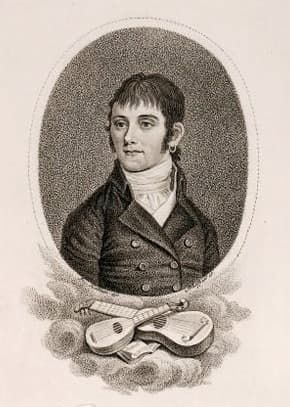
Bartolomeo Bortolazzi
It appears that Hummel wrote his mandolin concerto as a showpiece for Bortolazzi as the dedication on the title page reads, “For the maestro di mandolin.” Without doubt, the work highlights the technical and expressive qualities of the instrument. The soloist is primarily accompanied by strings, but the addition of two flutes and two horns in the orchestra adds some delicious coloring. The opening “Allegro moderato” sounds a bit like Rossini, but the technical and expressive resources of the mandolin are well demonstrated in a movement of formal clarity.
The central movement “Andante con variazioni,” delights in characteristic adaptations of the tune, and the concluding “Rondo” features a few solo passages in the winds. There are many charming imitative passages in the bass section of the orchestra, and don’t forget to note the two cadenzas for the solo instrument. Hummel was seemingly very proud of his composition as he made a transcription for fortepiano in 1816.
Johann Nepomuk Hummel: Mandolin Concerto in G Major, S 28 (Dorina Frati, mandolin; I Solisti di Fiesole; Nicola Paszkowski, cond.)
Francesco Giovanni Giuliani
Born in Livorno in 1760, Francesco Giovanni Giuliani (1760-1820) was a highly esteemed Italian harpist, composer, and conductor. He studied with the great Pietro Nardini and spent almost his entire career in Florence. He held positions as first violin at the Teatro Nuovo, and as conductor at the Teatro degli Intrepidi. In fact, he was one of the few lesser Italian masters of the late 18th century who was able to make a living as an instrumental composer in his own country.
Not needing to travel elsewhere or to compose church and theatre music, Giuliani focused on instrumental genres. In his mandolin concerto, Giuliani relies on the “assimilation of the gallant style of his teacher Nardini, made up of formal rigor, sharpness of the tonal system, and smoothness of the melodic line.”
Francesco Giovanni Giuliani: Mandolin Concerto (I Solisti Aquilani; Vittorio Antonellini, cond.)
Herbert Baumann
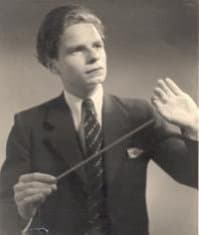
Herbert Baumann
Herbert Baumann (1925-2020) studied composition with Paul Höffer and Boris Blacher, and conducting with Sergiu Celibidache in Berlin. Baumann composed music for about 500 stage productions and music for about 40 television plays. His ballet scores for “Alice im Wunderland” and “Rumpelstilzchen” have been performed at various opera houses throughout Germany.
In 1998, Bauman founded the Herbert-Baumann-Stiftung, a foundation for the support of plucked instruments for concerts, festivals, and competitions. His mandolin concerto is an extension of the classical music tradition, and Baumann combines various musical styles to create his own personal sound. The music seems to freely float across a number of genres and borders and contains various post-tonal techniques and a touch of folk. And while lack of academic recognition kept the instrument out of the conservatories for a long time, Baumann was part of a dedicated group of composers and performers to bring the instrument to renewed popularity.
Herbert Baumann: Mandolin Concerto (Gertrud Troster, mandolin; Capella Bydgostiensis; Herbert Baumann, cond.)
Emanuele Barbella
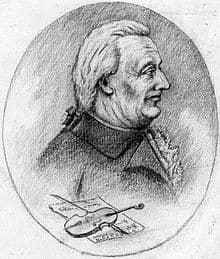
Emanuele Barbella
Let’s return to Naples once more and take a look at Emanuele Barbella (1718-1777). He was an esteemed violinist and composed a significant number of compositions for string instruments. Some have been revived and recorded, but others are still only found in manuscript form. We know that he learned the violin from his father and that he studied at one of the four original conservatories in Naples.
The music journalist Charles Burney wrote in 1771, “Barbella is the kindest human being that I’ve ever known, with a character as sweet as the sound of his violin. Barbella visited London in the 1760s and made good friends with William Hamilton, Britain’s Minister at the Bourbon Court. Barbella composed a vast array of music for solo string instruments, including a number of concertos for mandolin.
In his Concerto for Mandolin and 2 Violins Barbello demonstrates his profound knowledge of the instrument. This three-movement concerto owes much to the gallant style. Ornate arpeggios associated with the mandolin sound in the opening movement, spiced up by abrupt changes from the major to the minor mode. The final movement is stereotypical of the Neapolitan style, with harmonic and spirited simplicity sounded in dancing passages in the form of a tarantella.
Emanuele Barbella: Concerto for Mandolin and 2 Violins (Aino Hildebrant, violin; Julie Maas, violin; Anna Torge, mandolin; Kölner Akademie; Michael Alexander Willens, cond.)
Avner Dorman
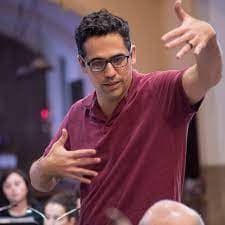
Avner Dorman
Avner Dorman (b. 1975) studied composition with John Corigliano at the Juilliard School and served as composer-in-residence for the Israel Camerata from 2001 to 2003. He explains that he always loved baroque music, and “even as a young child I found baroque very exciting and closer to the music of our day.” He admired the clear rhythms, the strong reliance on the bass, and the extreme contrasts in the music.
As a composer, Dorman loves to discover and explore new instruments, and in 2006 Avi Avital approached him to write a Mandolin Concerto. As he writes, “my acquaintance with the mandolin was fairly limited, but as I got to know the instrument better, I discovered its diverse sonic and expressive possibilities.” For the composer, his Mandolin Concerto features conflicts between sound and silence and between motion and stasis. “What inspired me to deal with these opposites is the mandolin’s most basic technique – the tremolo, which is the rapid repetition of notes. The tremolo embodies both motion and stasis.”
Avner Dorman: Mandolin Concerto (Avi Avital, mandolin; Metropolis Ensemble; Andrew Cyr, cond.)
Did you enjoy this little exploration into the 10 most exciting mandolin concertos? Many more such works have been, and continue to be written. But I wanted to leave you with one of my all-time favorites, the Concerto for 2 Mandolins by Antonio Vivaldi. The Baroque instrumental concerto started with Vivaldi, and we still like his music because of the predictability of the ritornello structure. I really disagree with Igor Stravinsky who said, “that Vivaldi was a dull fellow who did not compose 500 plus concertos, but he composed one concerto 500 times.” It seems to me that Vivaldi shaped an entire century of music-making.
For more of the best in classical music, sign up for our E-Newsletter

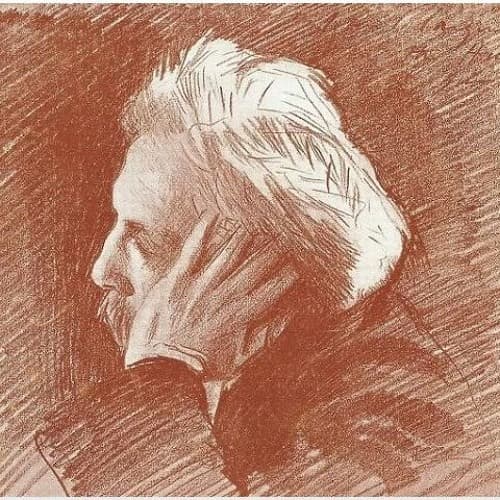
In the early eighteenth century, the mandolin was popular in Southern Italy, especially in Naples. The instrument was consistently used for informal music making, and important changes allowed the instrument to enter the world of art music. It was previously tuned in fourths and thirds, but in the second half of the 18th century the tuning in fifths, as with the violin, was adapted.